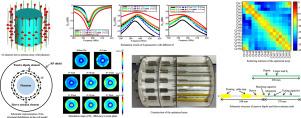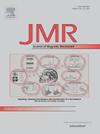基于无源去耦方法的 16 通道套筒天线阵列,14 T。
IF 2
3区 化学
Q3 BIOCHEMICAL RESEARCH METHODS
引用次数: 0
摘要
在超高场,尤其是 14 T 时,头部线圈阵列面临着元件间耦合的巨大挑战。虽然无源去耦方法可以减少这种耦合,但去耦元件会对磁头阵列的射频场造成破坏性干扰,从而降低 B1+ 效率。这种效应造成的 B1+ 损耗可能比元件间耦合造成的损耗还要高。具体来说,我们利用无源偶极子天线对 16 通道套筒天线阵列进行去耦,并对其位置进行了优化,通过增大其与有源天线的距离,最大限度地减少对阵列射频场的破坏性干扰。我们利用电磁模拟来优化无源偶极子的位置,以获得阵列的最佳性能。此外,我们还引入了一个 16 通道偶极子天线阵列,以便在使用人体模型评估套筒天线阵列性能时对阵列性能进行比较。我们还构建了优化的套筒天线阵列,并测量了其 S 参数,以验证去耦策略的有效性。结果表明,改进的无源去耦方法可以很好地降低去耦元件对射频场的破坏性干扰。采用这种方法开发的套筒天线阵列具有更高的 B1+ 效率和更好的传输性能。本文章由计算机程序翻译,如有差异,请以英文原文为准。

16-channel sleeve antenna array based on passive decoupling method at 14 T
At ultra-high fields, especially at 14 T, head coil arrays face significant challenges with coupling between elements. Although passive decoupling methods can reduce this coupling, the decoupling elements can cause destructive interference to the RF field of the head array, thus reducing the efficiency. The loss due to this effect can be even higher than that due to inter-element coupling. In this study, we develop a novel passive decoupling method to improve the performance of head coil arrays at 14 T. Specifically, passive dipole antennas were utilized to decouple the 16-channel sleeve antenna array, with their positioning optimized to minimize destructive interference with the array’s RF field by increasing their distance from the active antennas. We used electromagnetic simulations to optimize the position of the passive dipoles to obtain the best performance of the array. In addition, we introduced a 16-channel dipole antenna array to compare the array performance when evaluating the sleeve antenna array performance using a human body model. We also constructed the optimized sleeve antenna array and measured its S-parameters to verify the effectiveness of the decoupling strategy. Our results show that the improved passive decoupling method can well reduce the destructive interference of the decoupling elements to the RF field. The sleeve antenna array developed under this method exhibits higher efficiency and better transmission performance.
求助全文
通过发布文献求助,成功后即可免费获取论文全文。
去求助
来源期刊
CiteScore
3.80
自引率
13.60%
发文量
150
审稿时长
69 days
期刊介绍:
The Journal of Magnetic Resonance presents original technical and scientific papers in all aspects of magnetic resonance, including nuclear magnetic resonance spectroscopy (NMR) of solids and liquids, electron spin/paramagnetic resonance (EPR), in vivo magnetic resonance imaging (MRI) and spectroscopy (MRS), nuclear quadrupole resonance (NQR) and magnetic resonance phenomena at nearly zero fields or in combination with optics. The Journal''s main aims include deepening the physical principles underlying all these spectroscopies, publishing significant theoretical and experimental results leading to spectral and spatial progress in these areas, and opening new MR-based applications in chemistry, biology and medicine. The Journal also seeks descriptions of novel apparatuses, new experimental protocols, and new procedures of data analysis and interpretation - including computational and quantum-mechanical methods - capable of advancing MR spectroscopy and imaging.

 求助内容:
求助内容: 应助结果提醒方式:
应助结果提醒方式:


